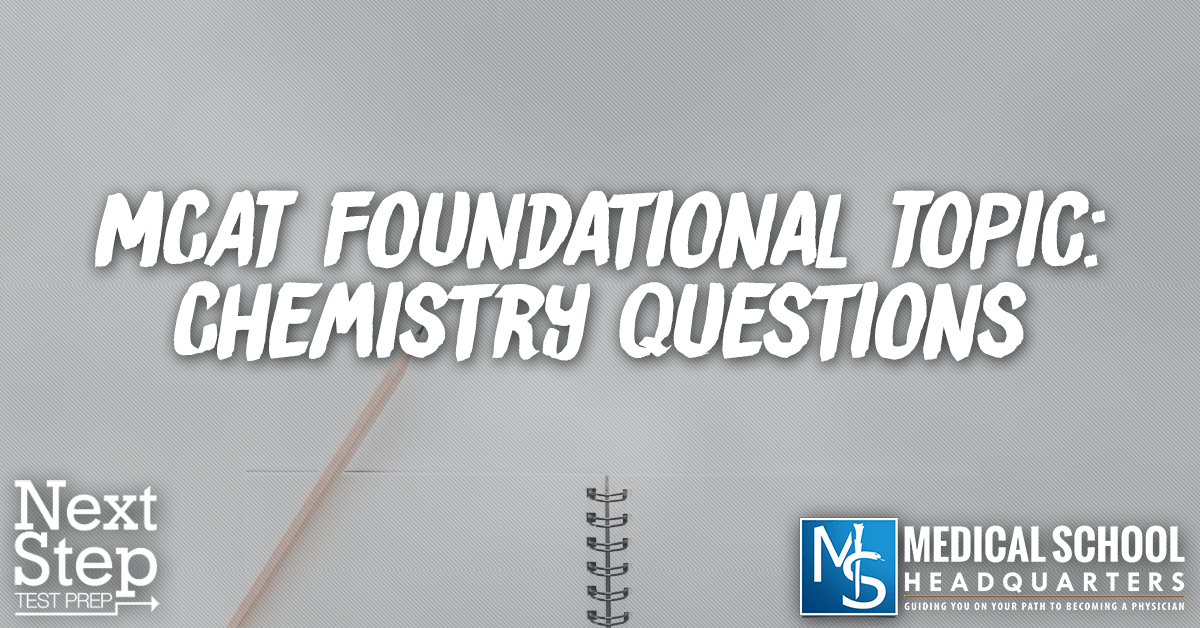Apple Podcasts | Google Podcasts

Session 82
Chemistry is one of the first classes you’ll take as a premed and it shows on the MCAT. Today we’ll cover some foundational topics related to chemistry.
Once again, Bryan of Blueprint MCAT (formerly Next Step Test Prep) is joining us as always. And by the way, don’t forget to check out all our other podcasts on MedEd Media.
This time, we’re doing General Chemistry so we’re going to the real basics – the atoms and compounds. By basic, it doesn’t mean it’s easy. These questions can still be tricky. They do require that you have mastered the fundamentals. That said, start by mastering the periodic table.
“The MCAT is a mile wide and an inch deep, but you really have to master that inch of depth that it has.”
[02:20] Molecules and Compounds
Question 5: Which of the following statements are true of CO2:
- It is a molecule.
- It is a compound.
III. Seven moles of it contain 3.5 moles of oxygen
- When mixed with water, one mole of it yields three ions.
Answer choices:
- (A) I and II
- (B) I and III
- (C) I and IV
- (D) II and IV
Bryan’s Insights:
Remember the definitions and this is true in all of MCAT. Make sure you understand and remember all of the definitions. First, a molecule is anything that’s multiple atoms stapled together. So O2 is a molecule. A polymer of esters and a single molecule can be three feet long but that’s still a molecule, anytime you stitch atoms together. For CO2, we stitched together three atoms that’s a molecule. So I. is correct.
A compound is a type of molecule that’s multiple so there are different kinds of atoms. O2 is an oxygen is a molecule, but not a compound. It’s just oxygen. Whereas CO2 is carbon and oxygen atoms so that’s a compound. So II. is also true.
So the answer here is (A). And you’re done!
[04:17] Ionic and Covalent Bonds
Question 7: Of these options, the elements that would form a bond with the least ionic character are:
- (A) N and O
- (B) B and S
- (C) H and F
- (D) Li and N
Bryan’s Insights:
When remembering ionic and covalent molecules, the ionic ones are those that happen when a molecule or atom gives its electron to its neighbor. And then they’re held together by electrostatics. So in table salt (NaCl), sodium gives out its electron and becomes Na+ and gives its electron to the Chlorine atom, making a Cl-. And then plus and minus 1, stick together and that’s how a table salt sticks together.
Covalent, on the other hand, refers to the sharing of electrons. Now the question said least ionic, so mostly kind of covalent.
The way to figure this out is looking at where the atoms are situated on the periodic table. Atoms that are far apart, all the way to the left and all the way to the right are going to be more likely to be ionic. And the atoms right next to each other in the periodic table are more likely to be covalent. If they’re next to each other and certainly if they’re in the same column, then that means they have similar behavior. So when they’re together, they’re going to want to share.
On the MCAT itself, you would have a periodic table, but you should be familiar enough with the periodic table to recognize that as you’re reading those answer choices, the very first choice, N and O are right next to each other on the periodic table. So when they form a bond, it is a polar covalent, but still covalent bond which as the least ionic character.
When you want to check the periodic table on the MCAT, it’s found on the upper right hand corner of the screen.
[06:44] Forming a Bond
Question 8: A particular element overwhelmingly prefers to form one bond and possess three lone pairs. Which group does this species likely belong in?
- (A) Group 1
- (B) Group 15
- (C) Group 17
- (D) Group 18
Bryan’s Insights:
This group would more likely be the halogens. This would be relatively straightforward once you recognize that description of halogens. You can just open the periodic table and look at what group it is and halogens are group 17.
[07:44] Blueprint MCAT (formerly Next Step Test Prep)
Don’t forget to check out Blueprint MCAT (formerly Next Step Test Prep). They’re online full length practice exams have just been revamped to match the new user interface that the AAMC and Pearson has ruled out for the MCAT. Use the promo code MCATPOD to save some money.
Links:
SEARCH SITE
SEARCH SITE
LISTEN FOR FREE











